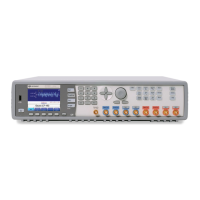Appendix
600
7.1 Direct Digital Synthesis
The Keysight 81150A / 81160A uses a signal-generation technique called
Direct Digital Synthesis (DDS) for all waveform functions except noise. As
shown below, a stream of digital data representing the desired waveform is
sequentially read from waveform memory and is applied to the input of a
digital-to-analog converter (DAC). The DAC is clocked at the 81150A /
81160A’s sampling frequency of 2 GHz for the 81150A (2.5 GHz for the
81160A) and outputs a series of voltage steps approximating the desired
waveform. A low-pass “anti-aliasing” filter then smoothes the voltage steps
to create the final waveform.
Waveform
Memory
Waveform
DAC
Anti-Aliasing
Filter
Address Data
2 GHz
Direct Digital Synthesis Circuitry
Direct Digital
Synthesis Circuitry
The 81150A / 81160A uses two anti-aliasing filters. A linear-phase filter is
used for all waveform functions.
For standard waveforms, and arbitrary waveforms that are defined with
fewer than 16,384 (16K) points, the 81150A / 81160A uses waveform
memory that is 16K words deep. For arbitrary waveforms that are defined
with more than 16K points, the 81150A uses waveform memory that is
524288 (512K) words (81160A uses 32k/64k/128k(2ch) or
64k/128k/256k(2ch)) deep.

